You may not find this terribly rewarding unless you're included here, so this is a good time for casual and random browsers to turn back before they get too caught up in the sweep and majesty of the proceedings and can't let go.
23 May 2018
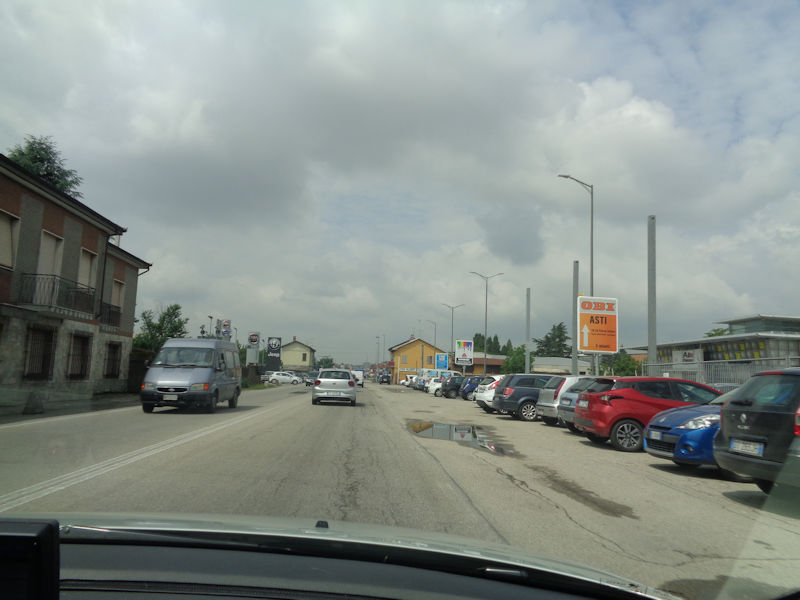
Asti, now a sizable comune of some 76,000 citizens on the Tanaro river and the capital of its own province in the Piedmont region, was an extremely important and extremely embattled city from the late Roman Empire, throughout the Middle Ages to the 16th century, and again in Napoleonic times -- we visited a few years ago and reported some of the main historical fun facts about the place at that time, and we'll try to refrain from repeating all of that here.
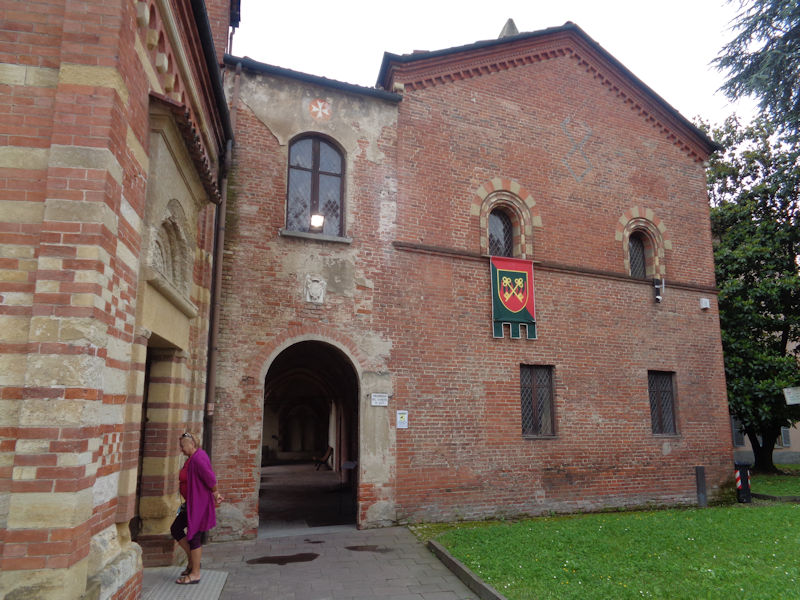
This is the Battistero di San Pietro in Consavia, a complex of four 12th and 14th century buildings now housing the Paleontological Museum of Asti, at the eastern end of the city centre on the east-west high street, the Corso Vittorio Alfieri.

The rotunda plan of the 11th century core of the place is said to have been inspired by the contemporaneous cult of the Holy Sepulchre of Jerusalem, riding the wave of pilgrimage enthusiasms of the First Crusade.
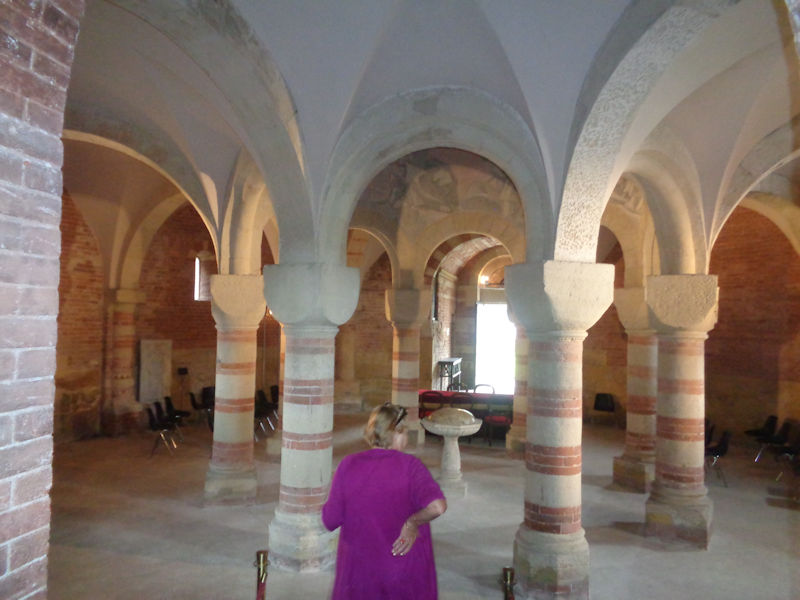
The marble baptismal font in the centre dates from the 16th century.

The attached complex of 13th and 14th century buildings, with a 15th century building enclosing the square on the eastern side, housed in addition to the church and its baptistery, and this cloister, a priory, and a hospital for pilgrims that was evidently associated with the Order of the Knights Hospitaller.
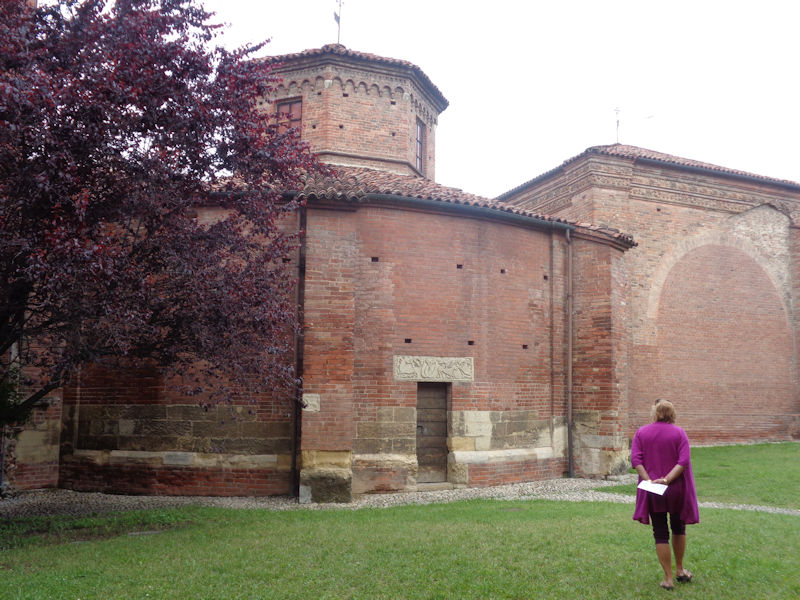
The back door of the baptistery rotonda. The complex was badly damaged during the 17th century wars in the Monferrato region, but has been restored since the 1930s; the Paleontological Museum was installed here in 1979.
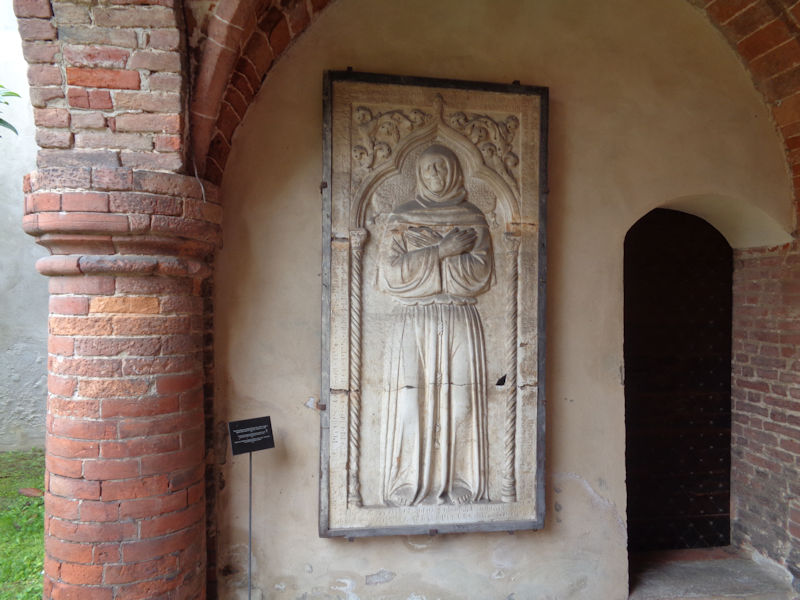
The St Peter mentioned is evidently not the famous Rock of the Catholic Church but rather St Peter the Farmer (or St Peter of Asti) [that's not him in the photo], who in the 11th century miraculously dug a spring on this spot for a convent that had no water, and founded a hospital next door. His relics are said to be enshrined within. The name Consavia appears to refer to the family that built the original church.
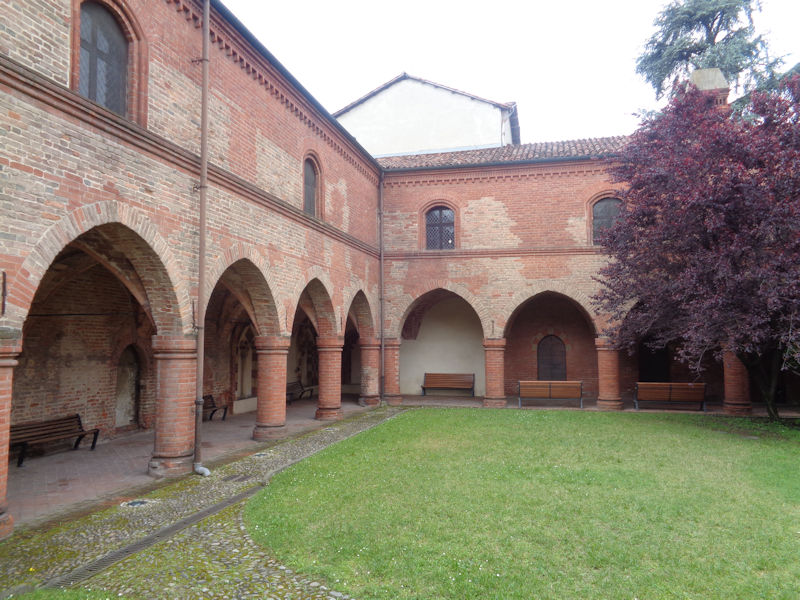
The cloister again. The museum was either closed or not closed at the moment -- the custodian was rude enough to send us off in a huff.
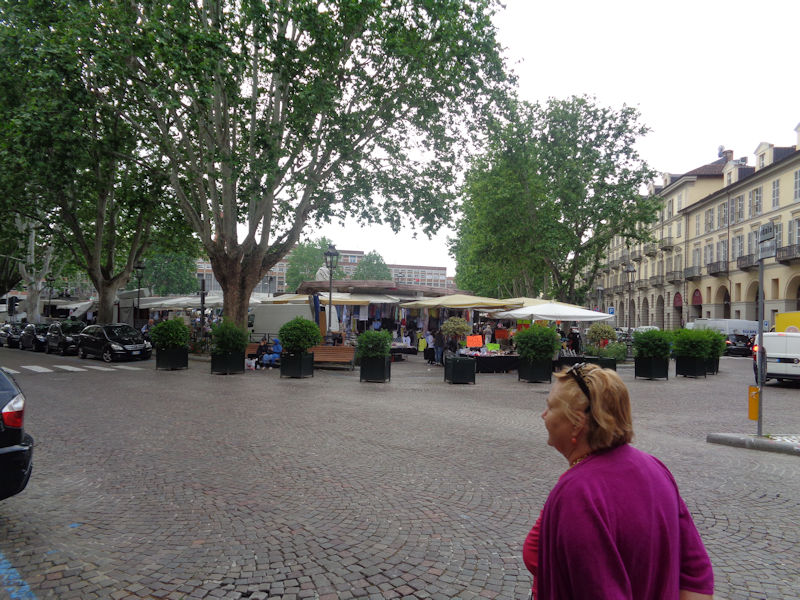
A street market in the Piazza Vittorio Alfieri, normally a huge carpark, leading at the far end to the much huger carpark (past the Ex-House of Fascism in the Piazza Libertà) of the Piazza Campo del Palio, the venue of the annual civic bareback horse races, the oldest recorded palio in Italy, commemorating the city's victory over Alba in some medieval squabble.
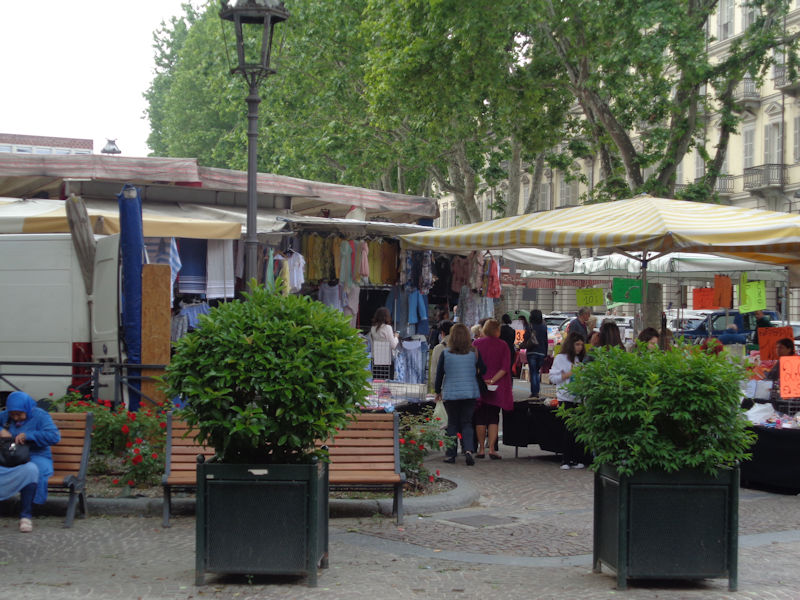
No street market left unsurveyed
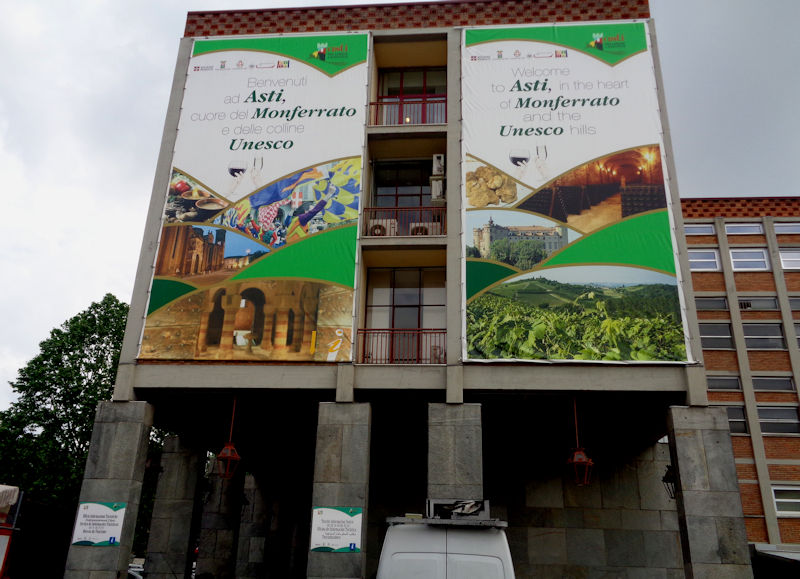
Proud tourist promotions of the UNESCO city hung on the side of the Prefecture building
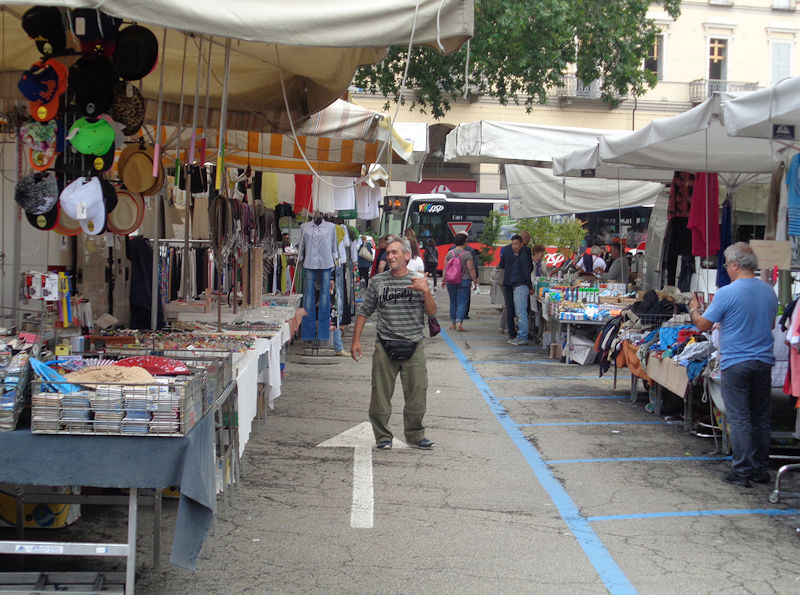
This gentlemen, apparently well known to the locals, was belting out selections from famous operas, and very well, too.

Farther along the Corso Vittorio Alfieri high street, named for an 18th century poet and tragedian who was born here but traveled widely and kept up a decades-long affair with Louise, the wife of Bonnie Prince Charlie.

The Torre Troyante clock tower (from 1260-1280)
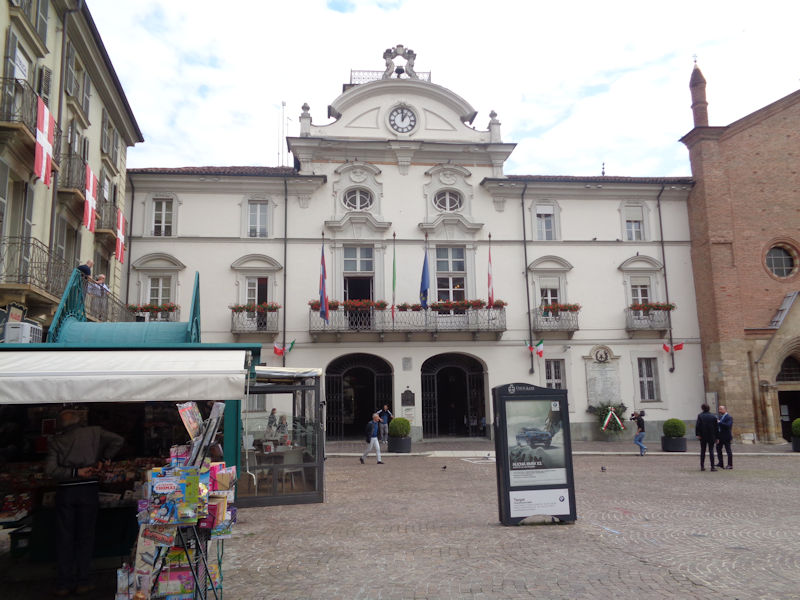
One block south of the Corso Alfieri, this is the Piazza San Secondo, and that's the Asti city hall, or Palazzo Civico.
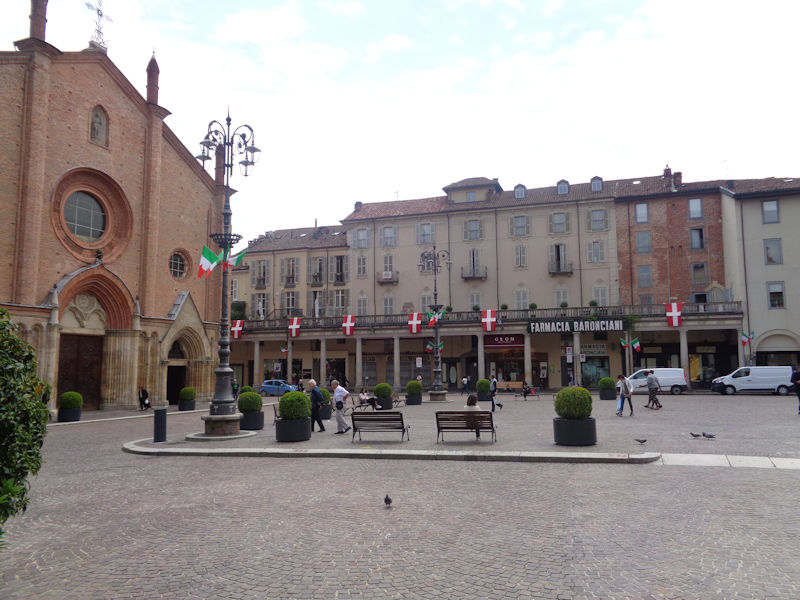
Saint Secondus, Asti's patron saint, was a wealthy local who is said to have been beheaded here in 119 by the unsympathetic Emperor Hadrian for his steadfast Christian allegiance.
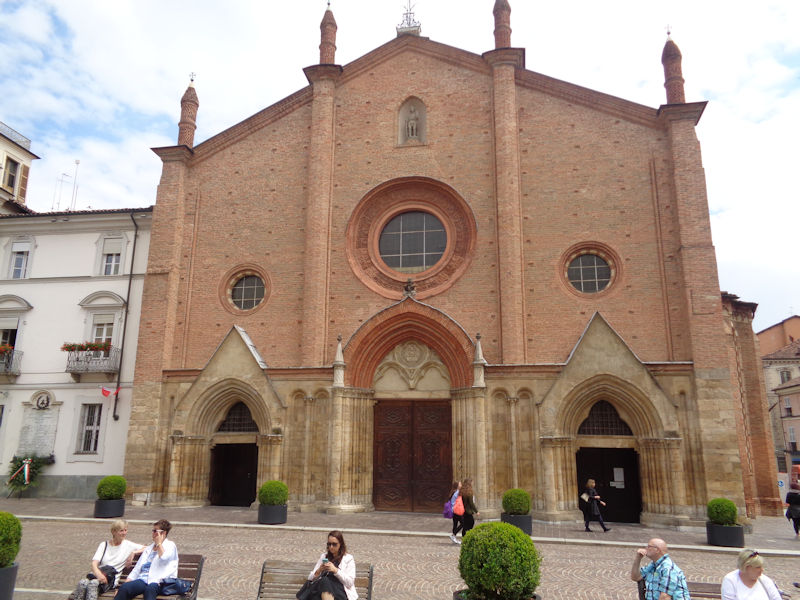
The three Gothic portals of the Collegiate Church of San Secondo, from the 13th century, but sporting a 6th century crypt inside.
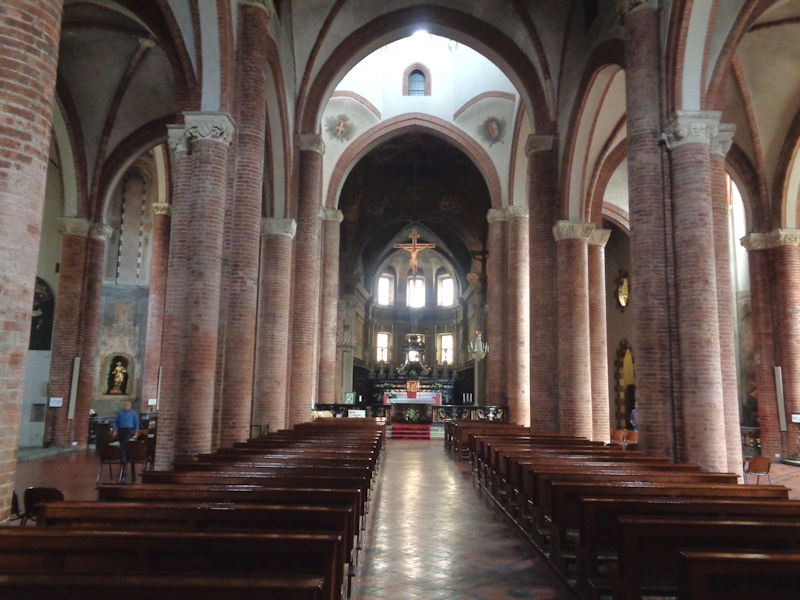
The central nave and two aisles

A side chapel with a fine pietà
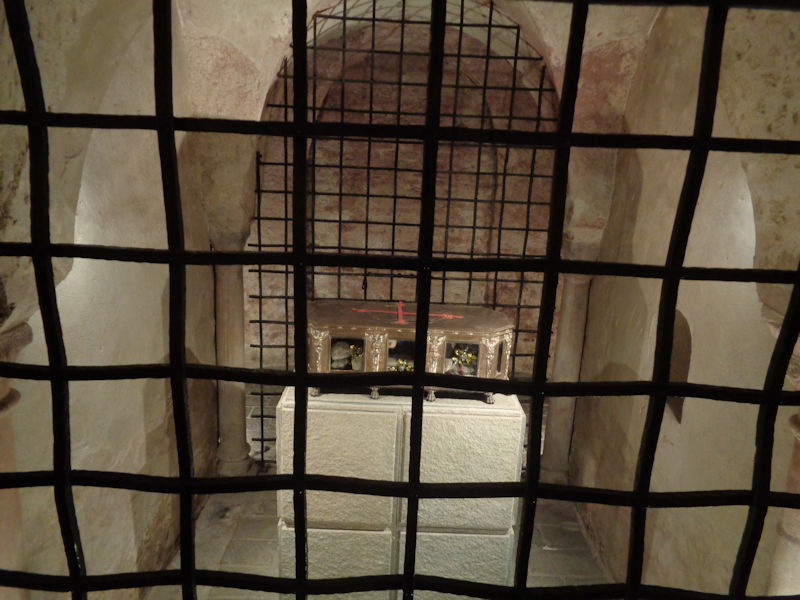
Relics of someone important, no doubt.

Kristin at the altar
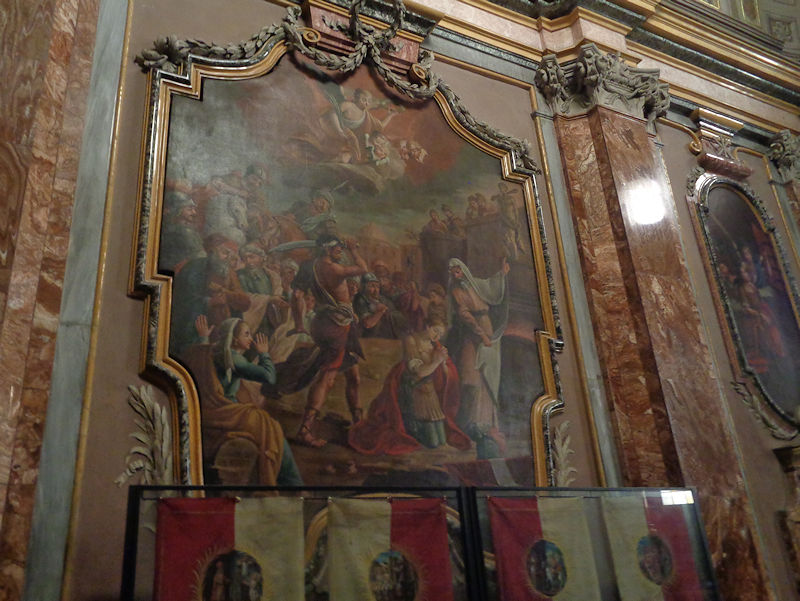
St Secundus being steadfast in the faith
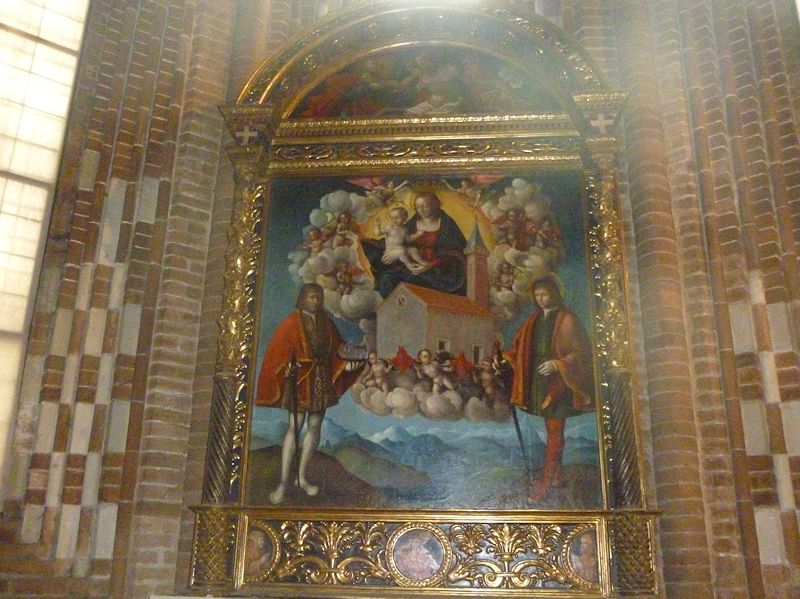
The Virgin Mary's house on its way from the Holy Land to Loreto, flown over by angels to save it from the Heathen when in 1291 the Crusaders were finally being expelled from Palestine.
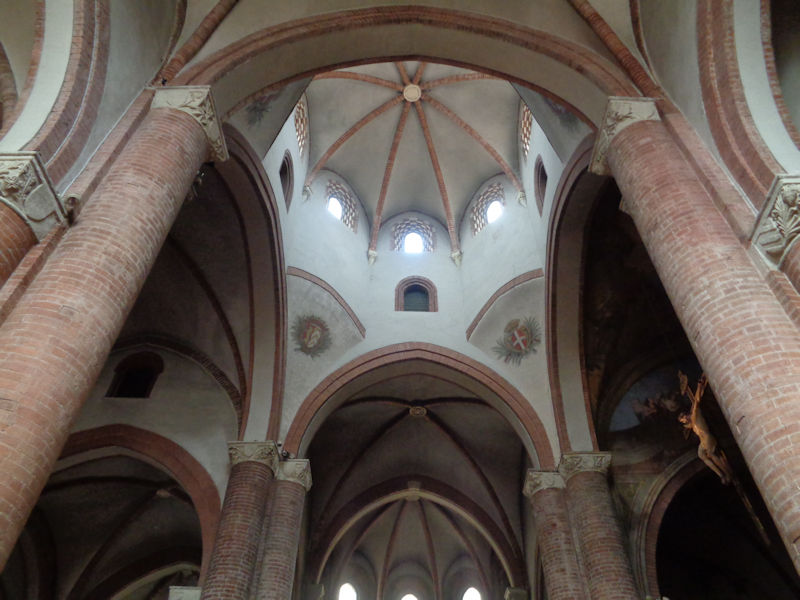
The dome above the crossing
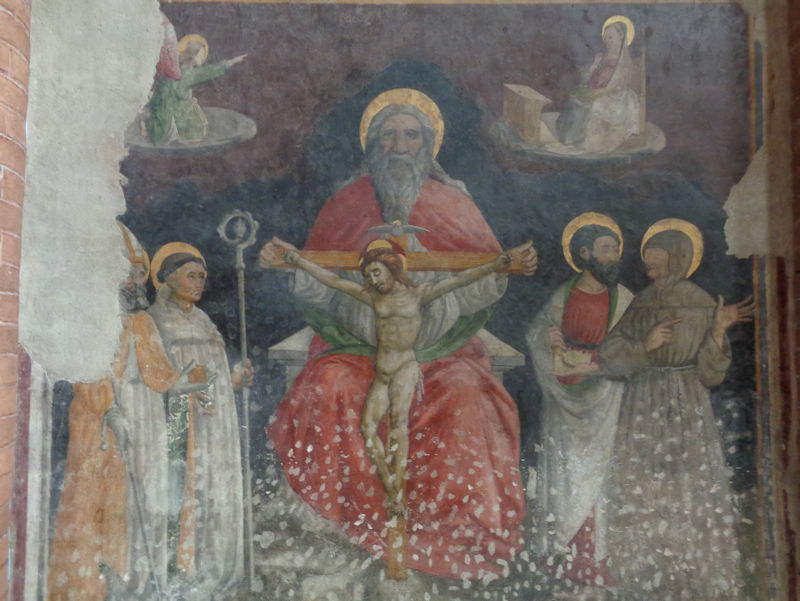
God the Supreme Father and friends
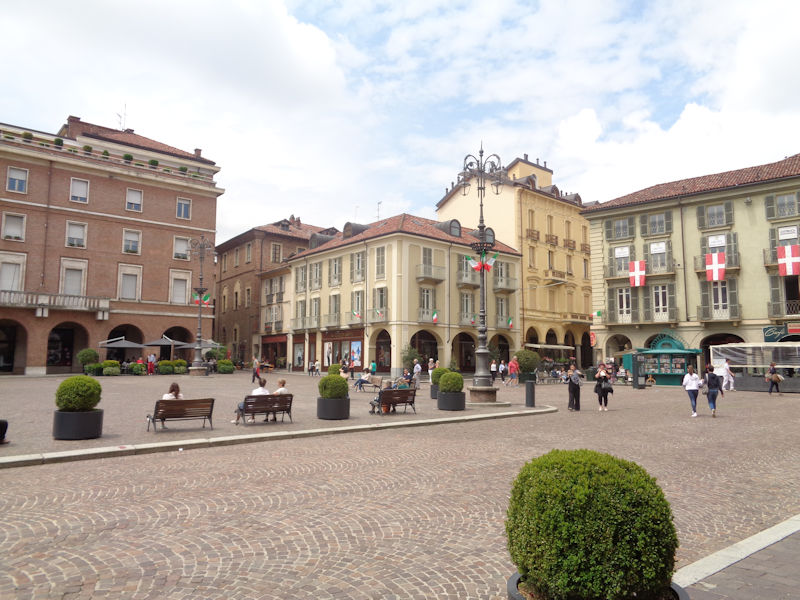
The Piazza San Secondo -- the so-called 'Palazzo del Podestà', actually a 13th century city hall, is the brown building down the street to the left of the white arcaded building.
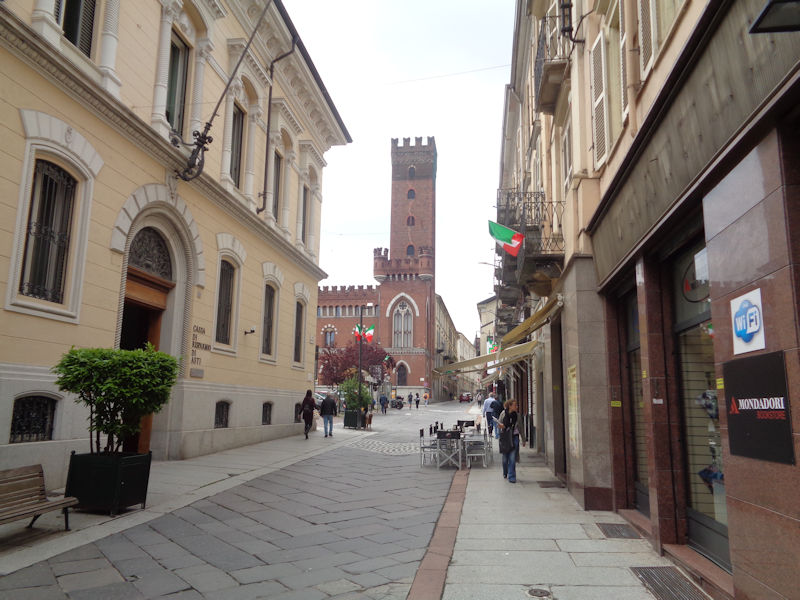
Farther westward along the Corso Alfieri

The Piazza Roma and the 13th century Tower of the Comentini -- Asti was evidently known as the City of a Hundred Towers, and there were about 120 of them at one time, of which 12 are still standing and apparently only one can be visited.
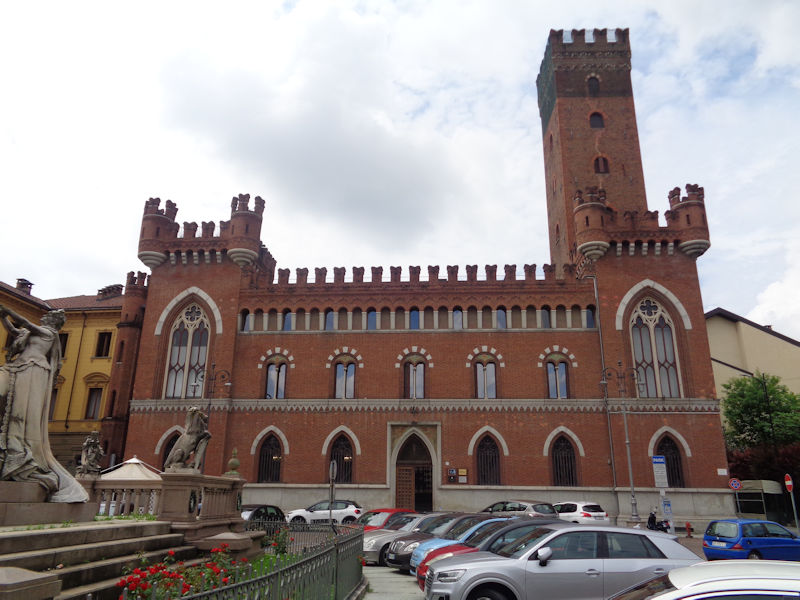
The tower is from the 13th century (with periodic repairs, as required), but the crenellated building attached to it is from the late 19th century.
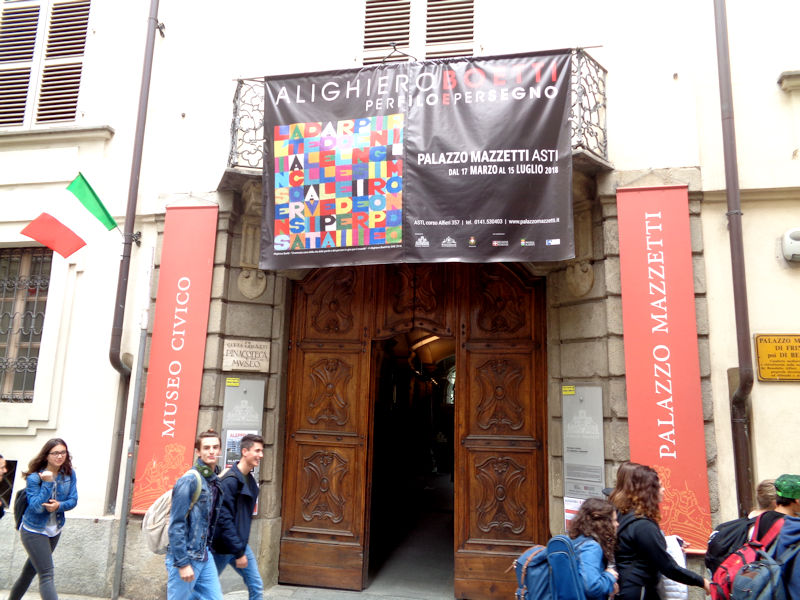
The Palazzo Mazzetti (the kids are just out of classes) houses the city museum and pinacoteca
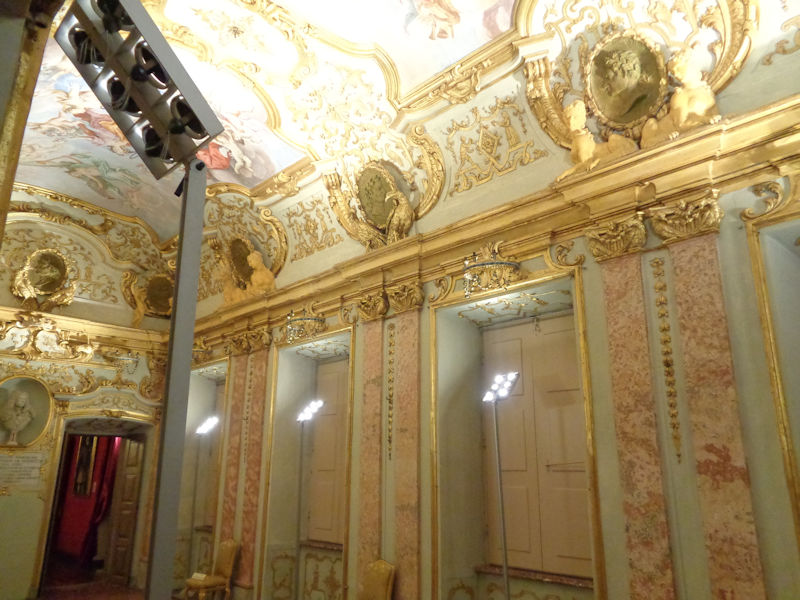
When we were last here, in 2014, this was a 'No Photo!' establishment, but it has since joined the modern ranks of the 'No Flash!' generation. The palace is remarkable, but there were no pictures that cried out to be photographed.
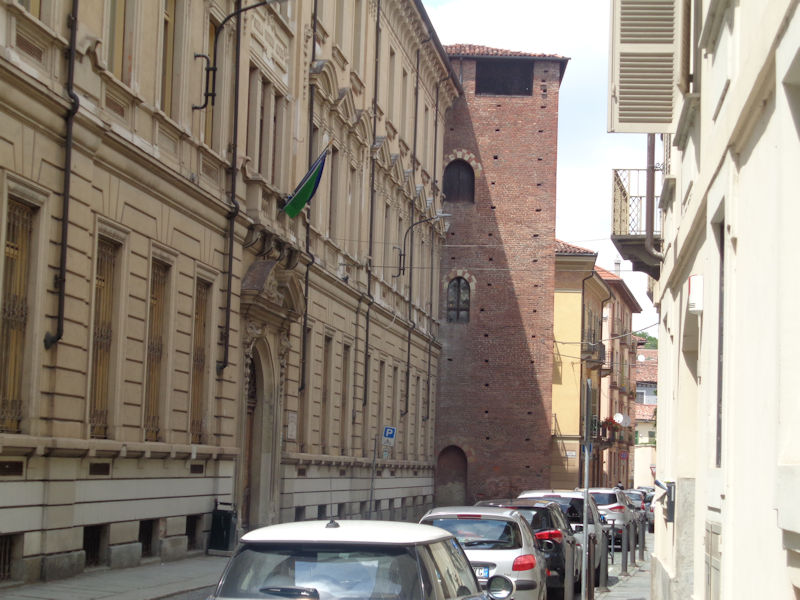
Just down a side street, that's the 13th century Gothic Torre Solaro, a private family's defensive tower that was certainly much taller in its heyday.
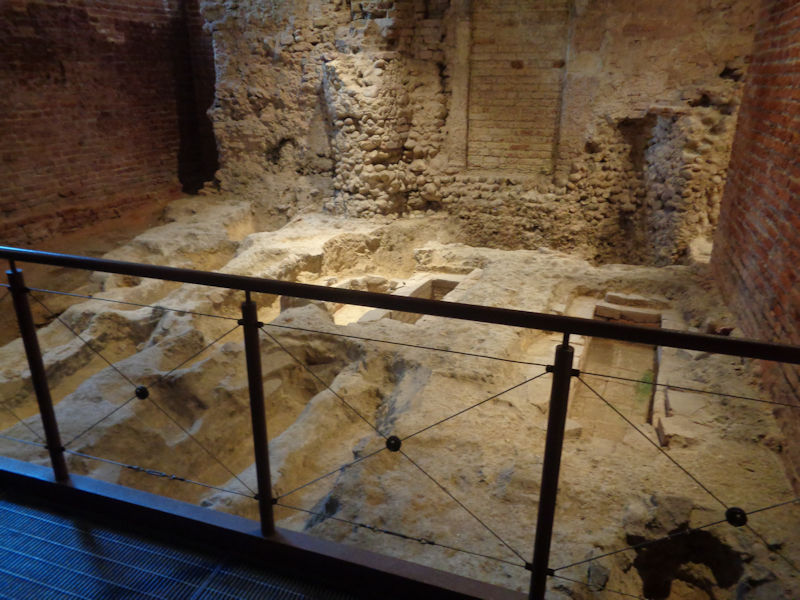
We're down in the Crypt and Museum of Sant’Anastasio (11th-12th century), also on the Corso Alfieri, described as a basilica building divided into three naves with vaulted ceilings and capitals recovered from Roman and early medieval predecessors, and with this nice crypt underneath it. It is presently both a museum and an active archaeological site.
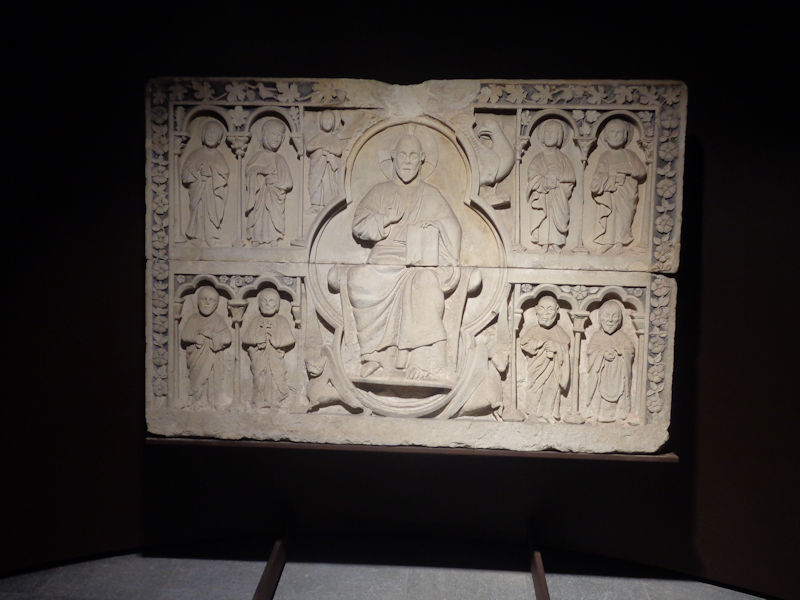
It's argued that the Anastasius to whom the original church, attested from 1008, was dedicated was St Anastasius of Persia, a Christianized Zoroastrian soldier who was decapitated for the faith near the Euphrates in 628 -- allegedly the great 8th century Lombard King Luitprand took up the cult of that saint, and as Asti was the seat of a Lombard duchy the king may have established the cult here. There are other folks, however, who think that Anastasius may just have been a very early Bishop of Asti.
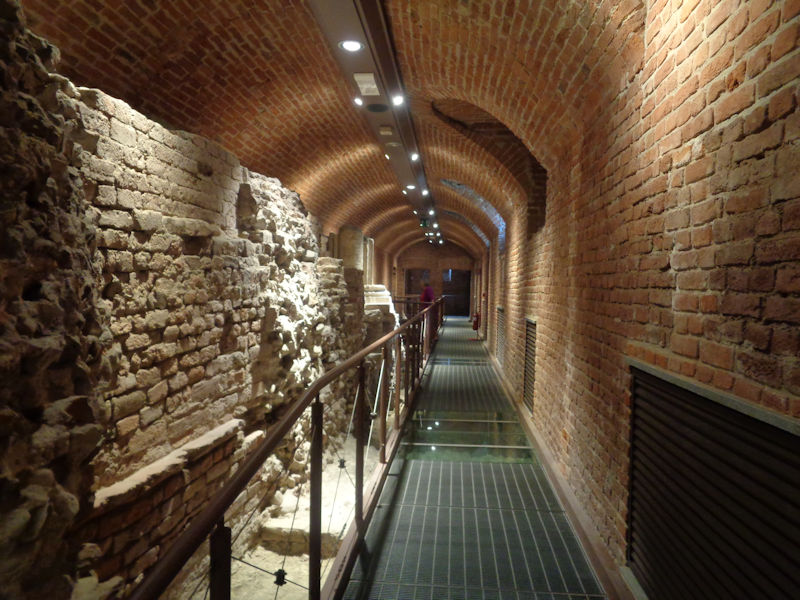
We're told that in the rooms adjoining the crypt are traces of Roman street pavements, evidence of settlements of the late Roman period, 8th-10th century tombs, part of the façade of the early medieval church of S. Anastasio (8th century), remains of the first Romanesque church (11th century), once part of a Benedictine abbey, and of a basilica above us from the early 17th century, which was demolished in the early 20th century.
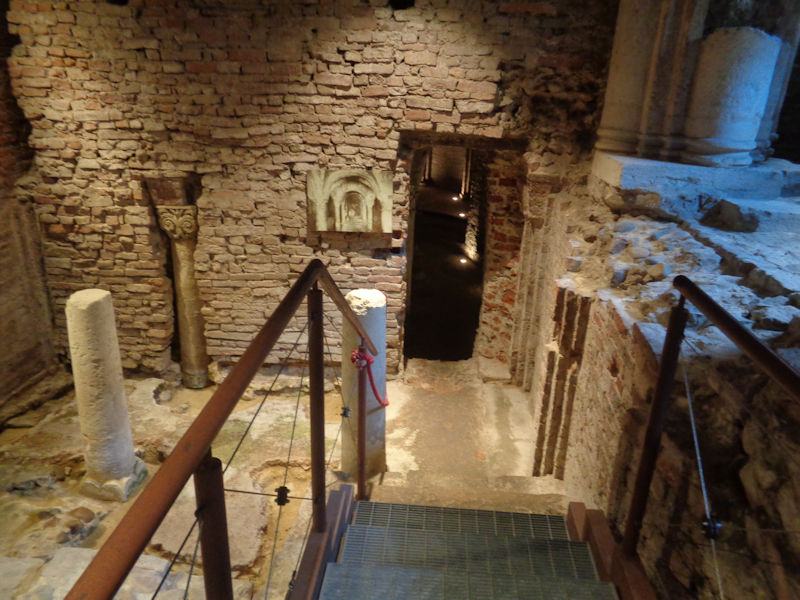
Descending into the saint's crypt

We're not going to meet Mr Anastasius himself on this trip, but his apartment looks rather too dark and not comfortable at all.
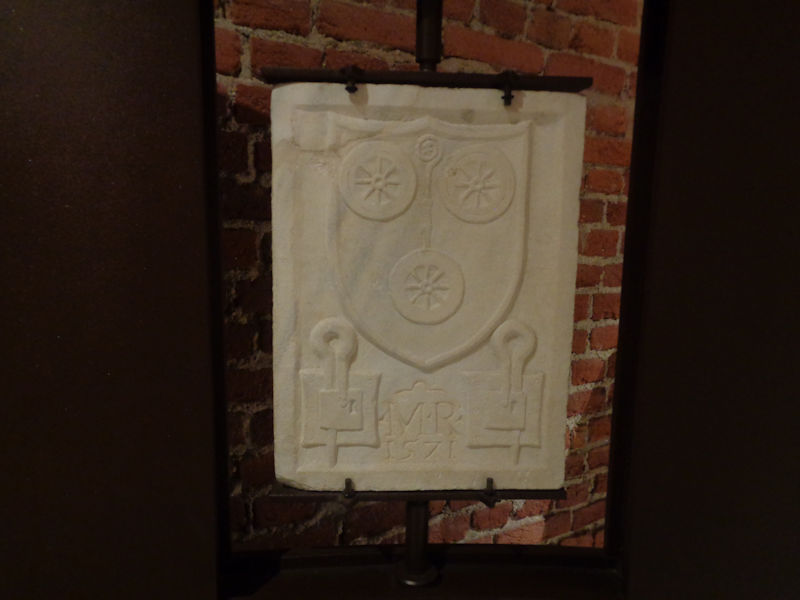
The escutcheon of the locally important Roero family, dated to 1571
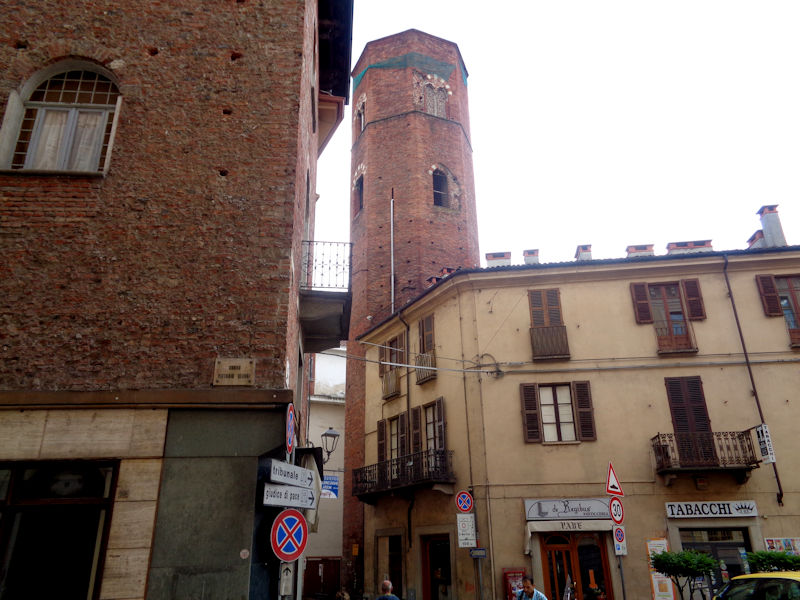
The octagonal Gothic Tower of the Regibus, built by the important Ghibelline family Re, or De Regibus, in the 13th century.
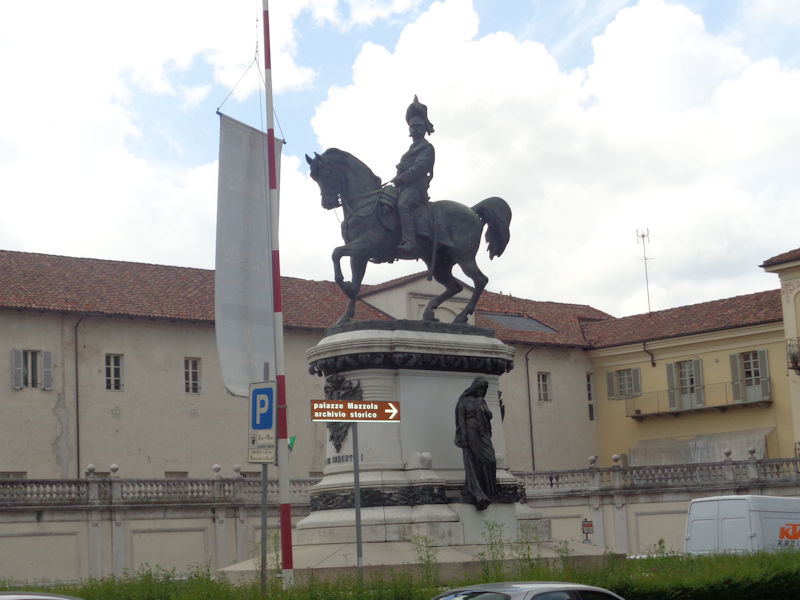
The equestrian monument to the stout Umberto I, King of Italy from 1878 to his assassination by an anarchist in July 1900. Hated by all progressives.
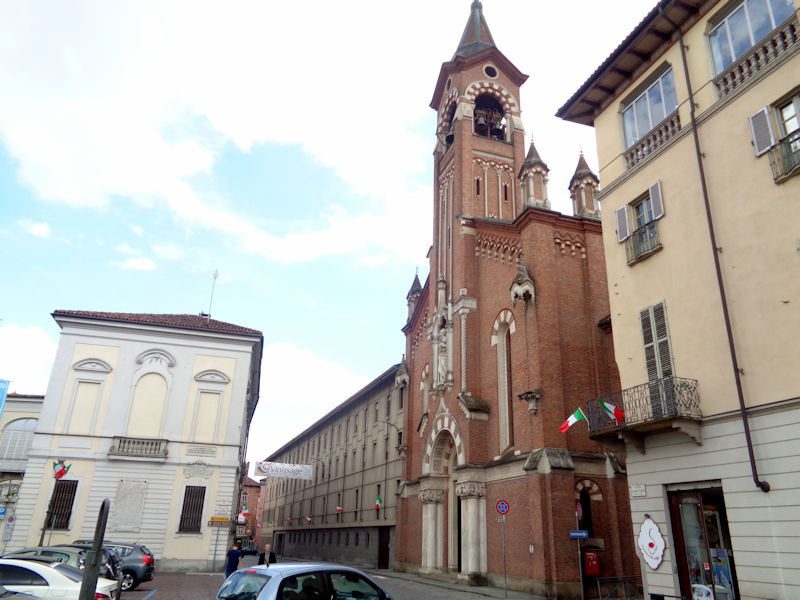
The Santuario di San Giuseppe on the Corso Alfieri, facing the Piazza Cairoli and King Umberto I with his funny hat. Built in 1931, it's dedicated to Saint Giuseppe Marello (1844-1895), a local fellow who became the Bishop of Acqui and founder of the Oblates of St Joseph Congregation and was known for his 'special devotion to the Virgin Mary' and for the miraculous healing of some malnourished kids. We peeked in during our last visit, and there's nothing for us there.

That's the Torre Rossa ('red tower'), containing elements of one of the two towers of the first century Roman city gate or perhaps of part of the Praetorian Palace of that time. In the 12th century it was adopted as a belltower for the Church of San Secondo, first mentioned in a donation by the redoubtable Countess Adelaide of Susa, Marchioness of Torino, in 1070 (coincidentally, the year in which she burned the city of Asti to the ground for its disobedience) -- that Romanesque church with its convent subsequently served as a refuge for the poor and for pilgrims and travelers. It's also known as the 'San Secondo Tower' based on a legend that Asti's patron saint was imprisoned in it before his martyrdom in AD 119.
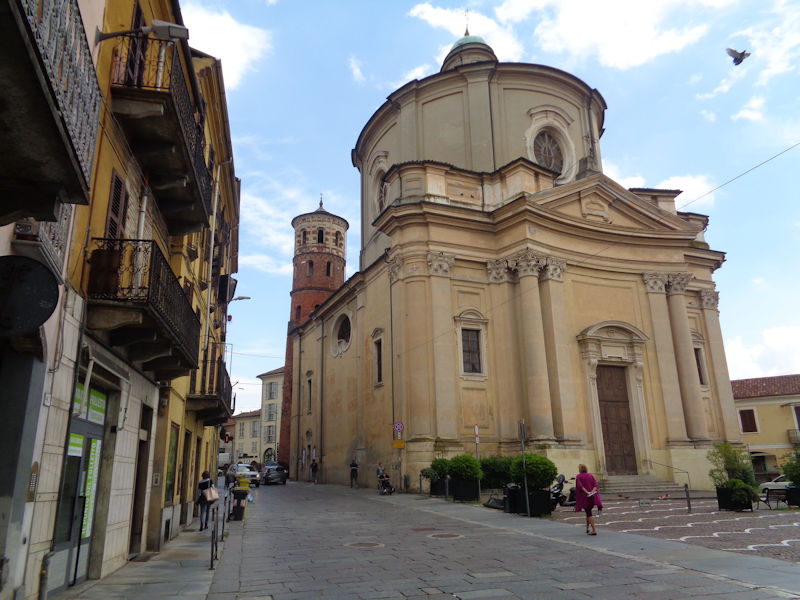
The Torre Rossa is presently backed upon the Baroque Chiesa di Santa Caterina, completed in 1773 and dedicated to the cult of Catherine of Alexandria, replacing the earlier church, which had to be demolished in 1732, but incorporating its ancient belltower.

We're on the Via del Varrone, having just passed the 'Domus Romana dei Varroni', vestiges of a 1st or 2nd century Roman house and subsequent 10th to 13th century additions along the old city wall, uncovered in excavations carried out for the building project in 1984. It was closed.
We should be coming up on the Cathedral very soon.
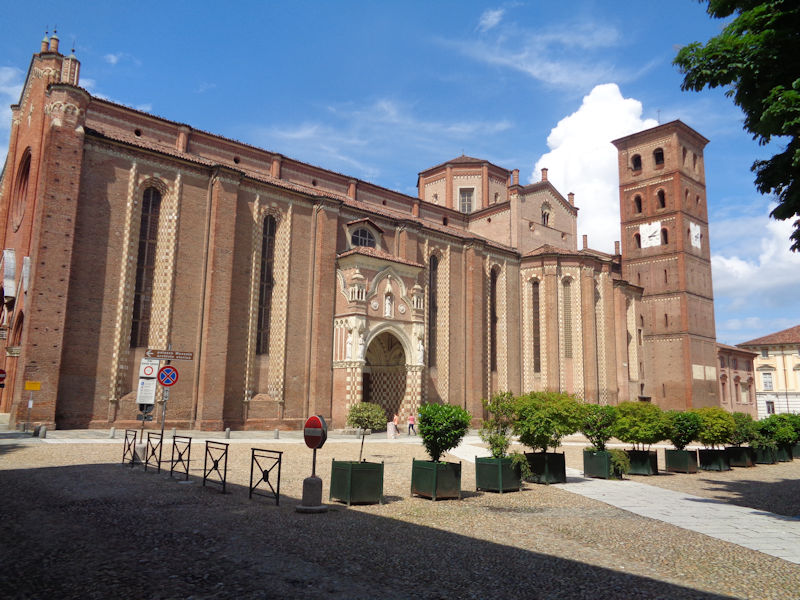
This is the fine Duomo di Asti, or Cattedrale di Santa Maria Assunta e San Gottardo, built upon the site of a primitive church containing the crypt of St Secundus and a 5th or 6th century successor cathedral that collapsed in about 1070 (when the redoubtable Countess Adelaide of Susa, Marchioness of Torino, burned the city down in her disputes with the bishops). The cathedral was then rebuilt and consecrated in 1095 by Pope Urban II, returning from having preached the First Crusade in Clermont, France.
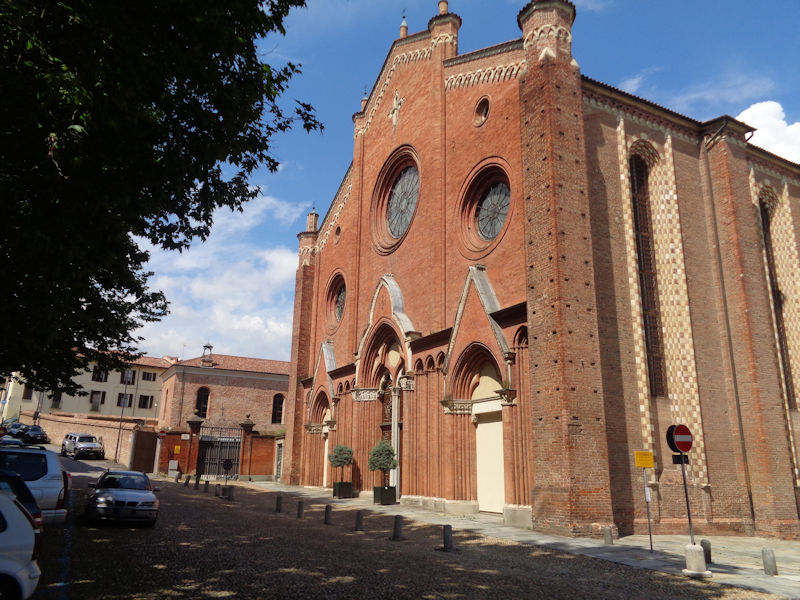
The Duomo was expanded and much improved through to the 14th century, and less drastically subsequently, but for the façade, with its three portals, the flanking two of them were walled up in 1711 to allow the addition of huge new frescoes on the interior counter-façade.

The main entrance to the Duomo is now the so-called Antiporta Pelletta, long understood to have been commissioned by the ancient and very important Pelletta family in the late 15th century, but apparently it's now considered that it was created in the early 14th century with decorative additions financed by Gerolamo Pelletta subsequently.

The Antiporta Pelletta, with statues of Jerome, Peter, Paul and Blaise at the corners and the Virgin Mary of the Assumption above them, all from 1470.
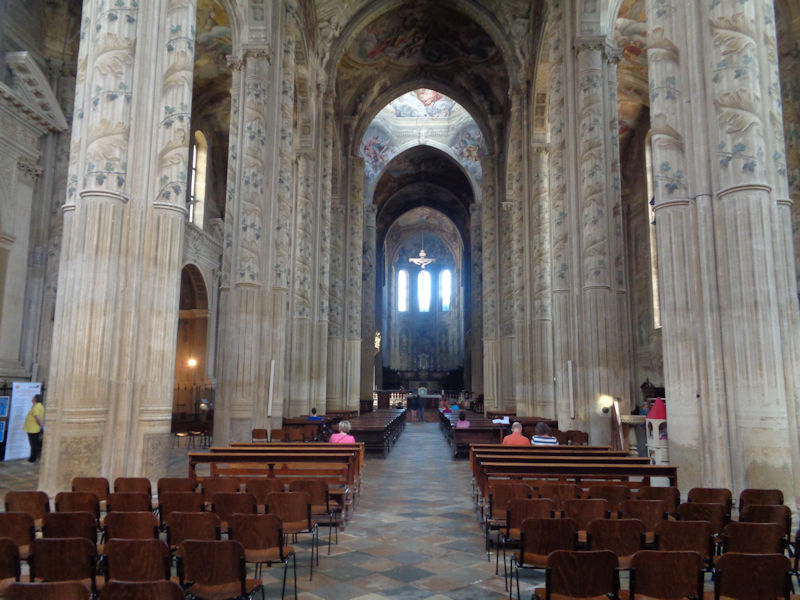
The nave, flanked by two side aisles

A baptismal font from 1468, with its cover locked down so the holy water can't be stolen for the purposes of witchcraft

Another goofy medieval font
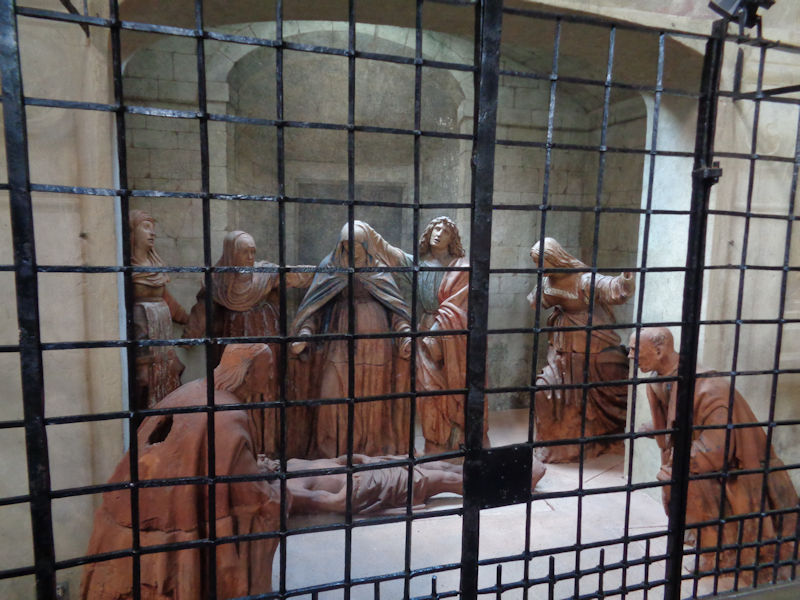
A stunning terracotta 'Complaint of the Dead Christ', from about 1500

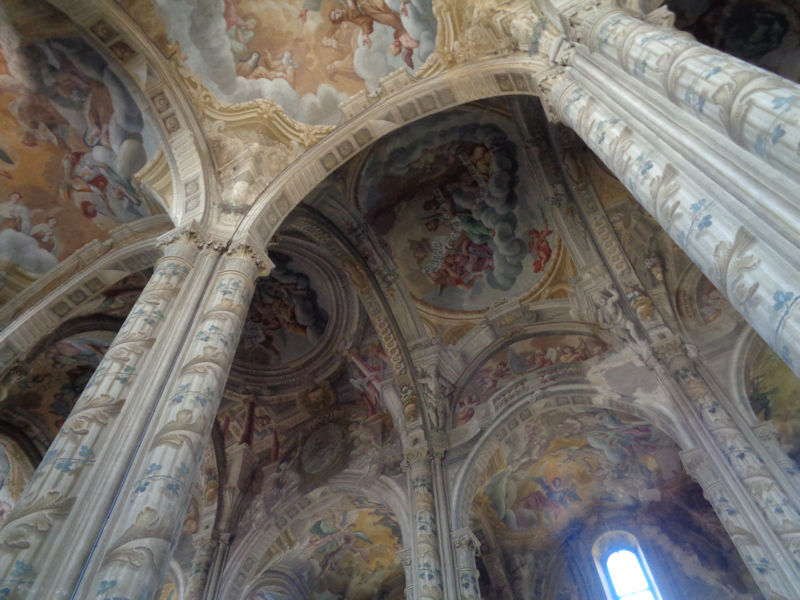
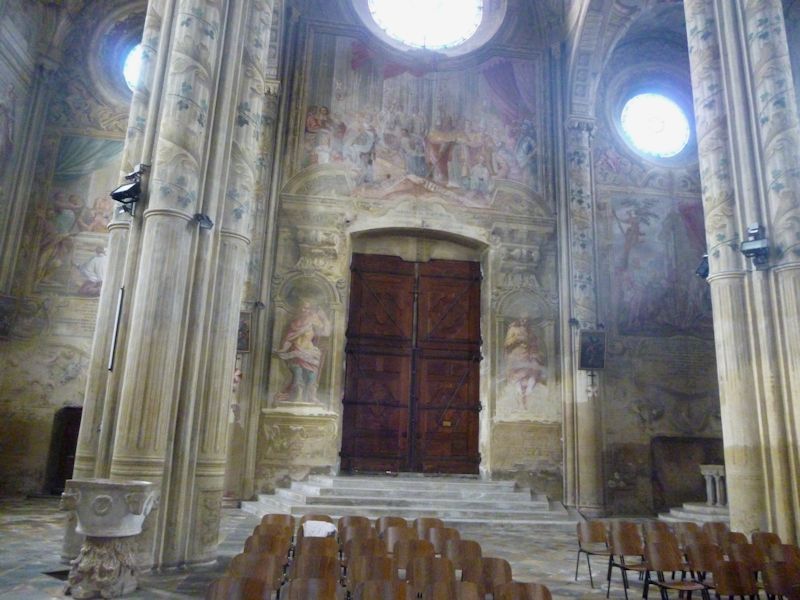
The counter-façade with its two flanking portals frescoed over in 1711
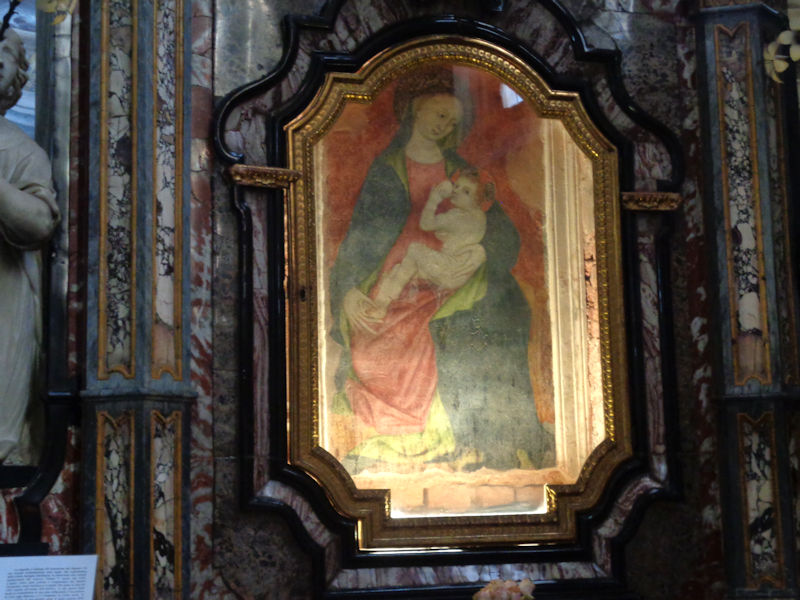
A nursing Madonna
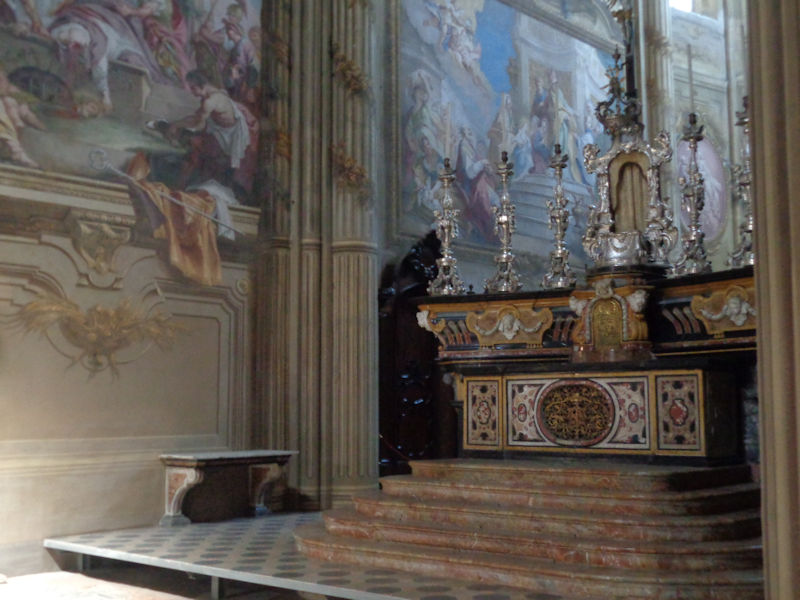
The high altar
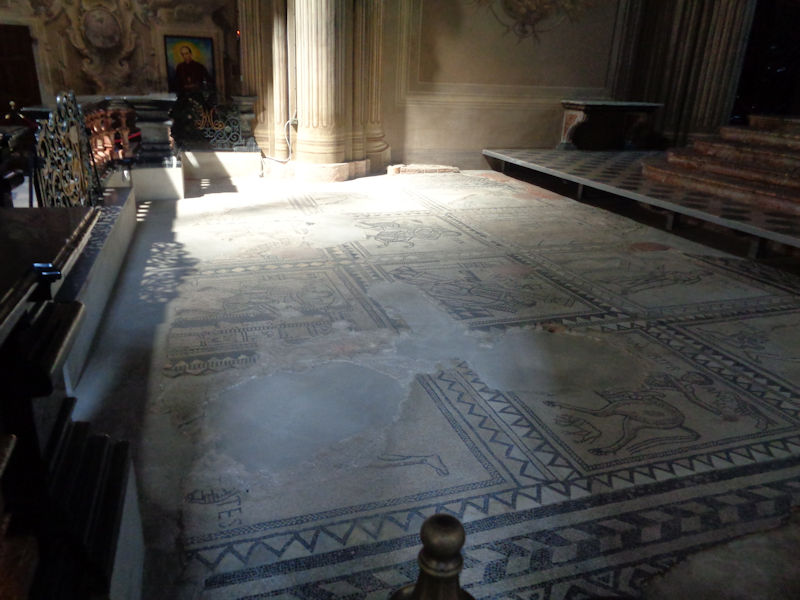
Mosaics in the presbytery illustrating the life of the biblical Samson, from the 12th and 13th centuries
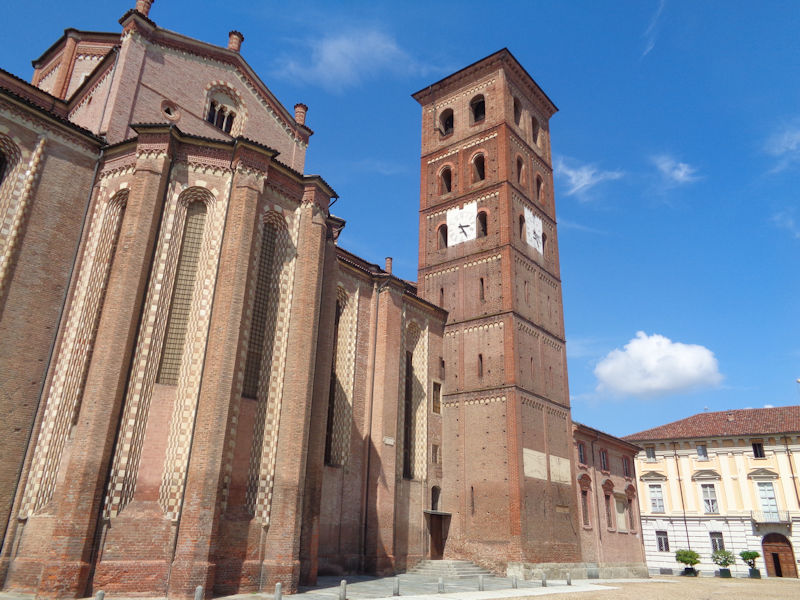
We're leaving the Duomo now, and its belltower from 1266, and leaving Asti soon afterward.

Through the villages back to Vignale Monferrato
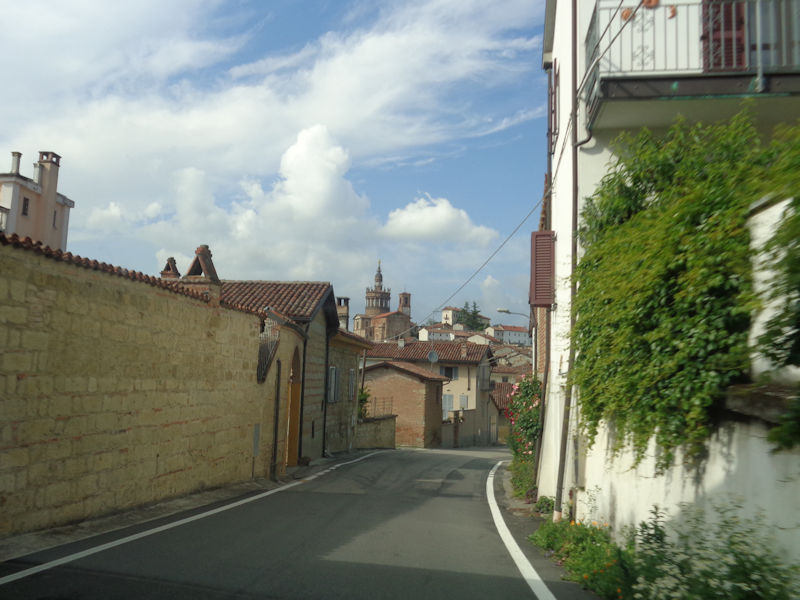
Through Camagna Monferrato, and off to dinner at the Osteria della Luna in Vignale
The road home
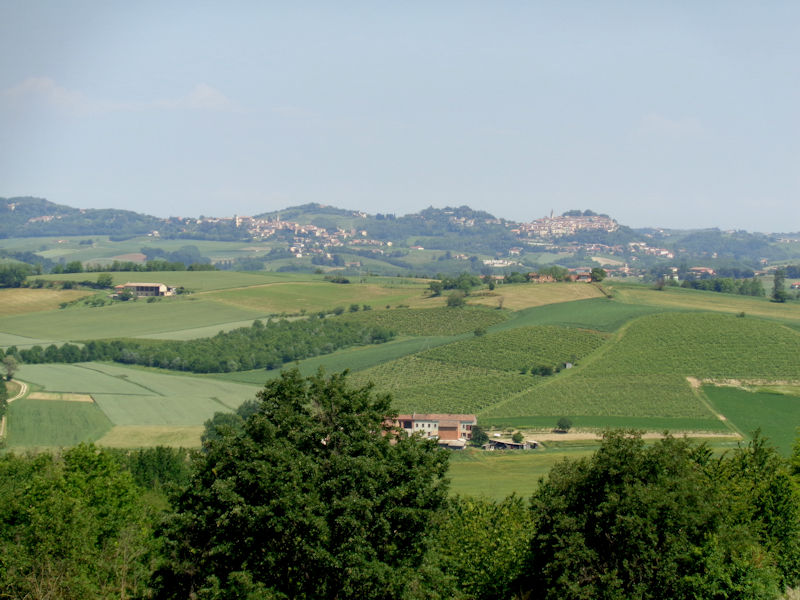
It will be hard to leave Vignale, and the Langhe and Monferrato, but needs must. This is a view of the neighborhood from the Casa nel Vento B+B, highly to be recommended.

From the Casa nel Vento, that's beautiful downtown Vignale Monferrato. We're soon starting out for home, 24 May 2018, but waiting for the Giro d’Italia cycling race to pass through Vignale, before setting out on our three hour drive to home in Ollon.
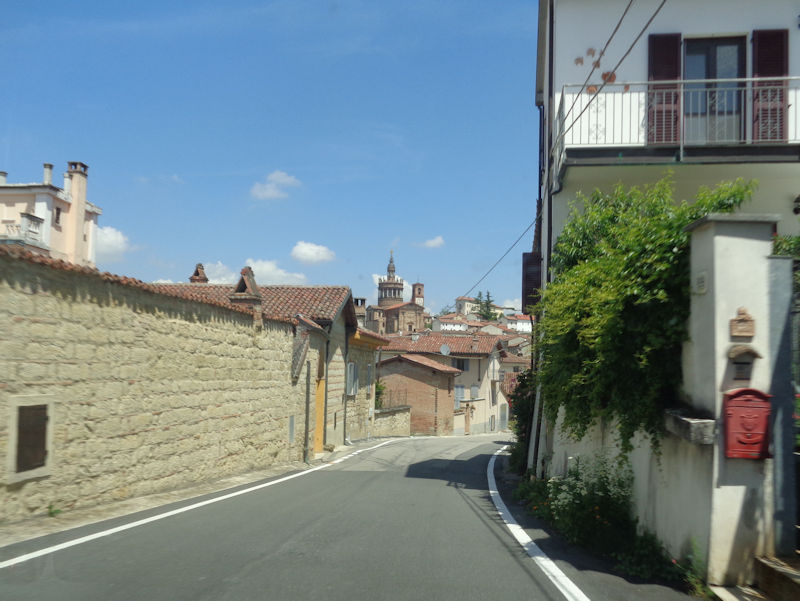
We're on our way now (through Camagna) -- though we still ran into a few detours from the cycling race on our way to the autostrada entrance at Casale Monferrato Sud.
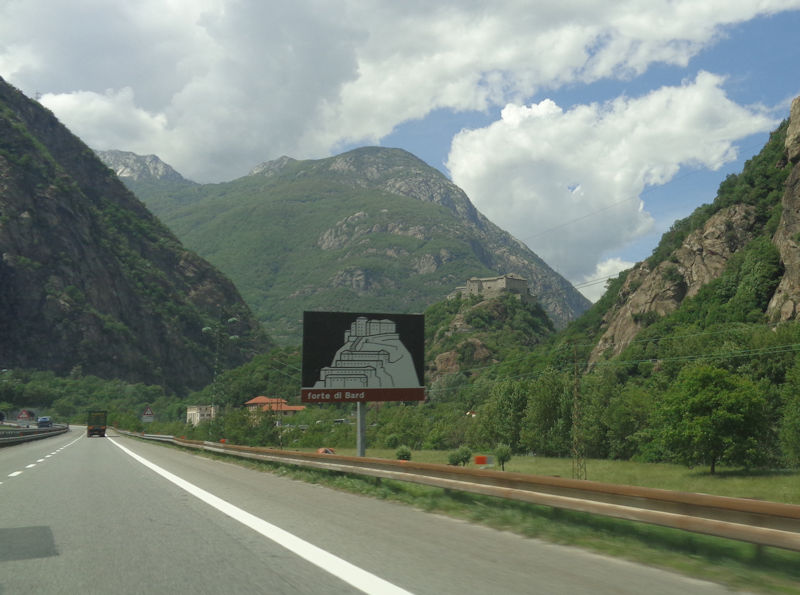
Up past Ivrea into the Aosta Valley, we're passing Fort Bard as we get more seriously up into the mountains.

Fort Bard from the south, fairly imposing -- back in the day, behind each of those windows, there were cannons that must to anyone with ill intentions give pause.

And again from the other side -- the old Fort Bard held Napoleon's surprise invasion up by two weeks (as I recall), and this 19th century Austrian establishment is very well kitted out for defenses, but now serves as host for a number of museums and exhibitions. We visited for the tour in 2015; it was cool.
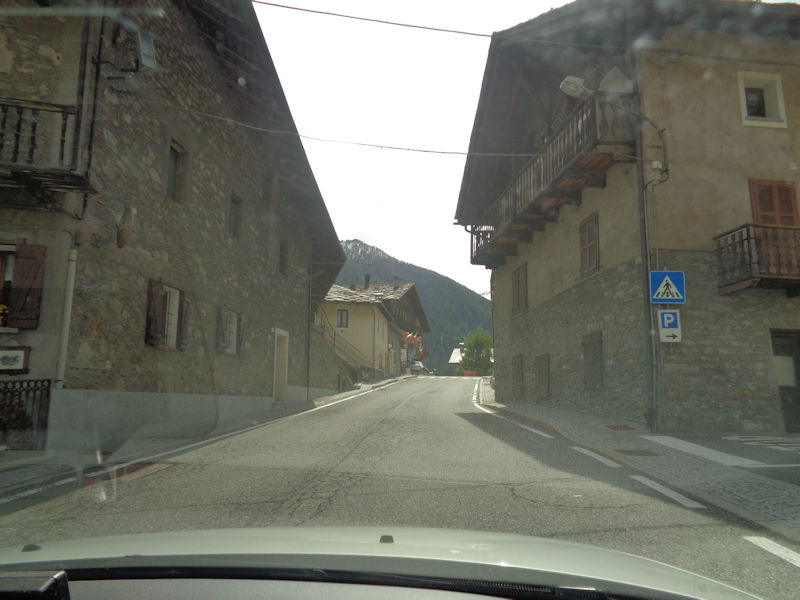
Higher up the mountain towards the Grand St Bernard, we passing through St-Oyens and looking forward to decompressing on the terrasse back in Ollon.

St-Oyen -- there's a half-finished bypass tunnel down past Etroubles below, to relieve the European truck traffic down this little road, but it's been mired in corruption, incompetence, and bankruptcies for several years. Sounds like Calabria, or Sicily.
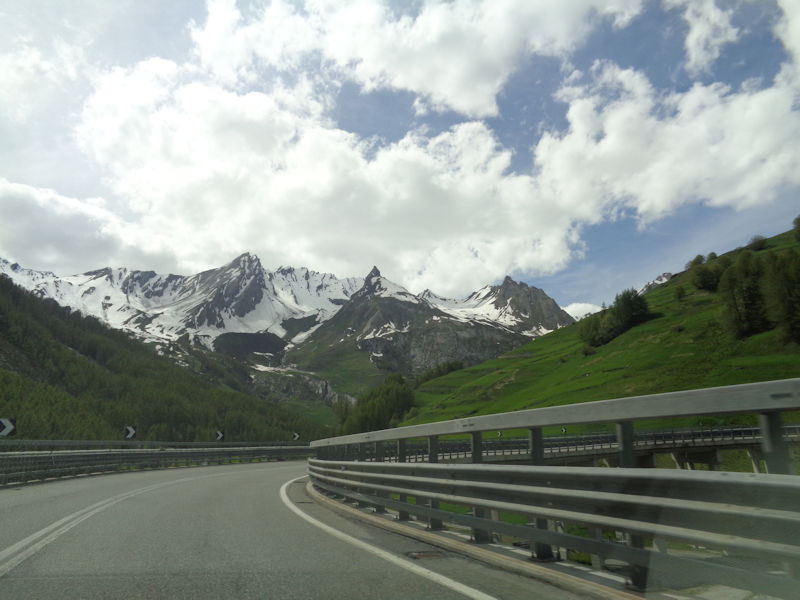
Towards the GSB Tunnel, for which we have an annual pass -- in full summer, one could bypass the tunnel and proceed over the pass itself, but in summer these days we're more likely to be found in Wisconsin, USA. But here's a midwinter ski up to the Pass from 1995.
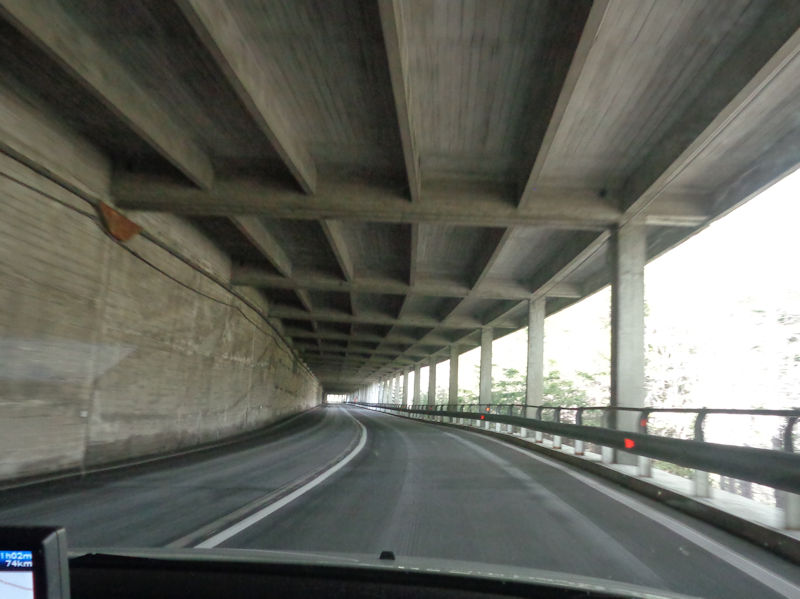
Through the avalanche galleries.
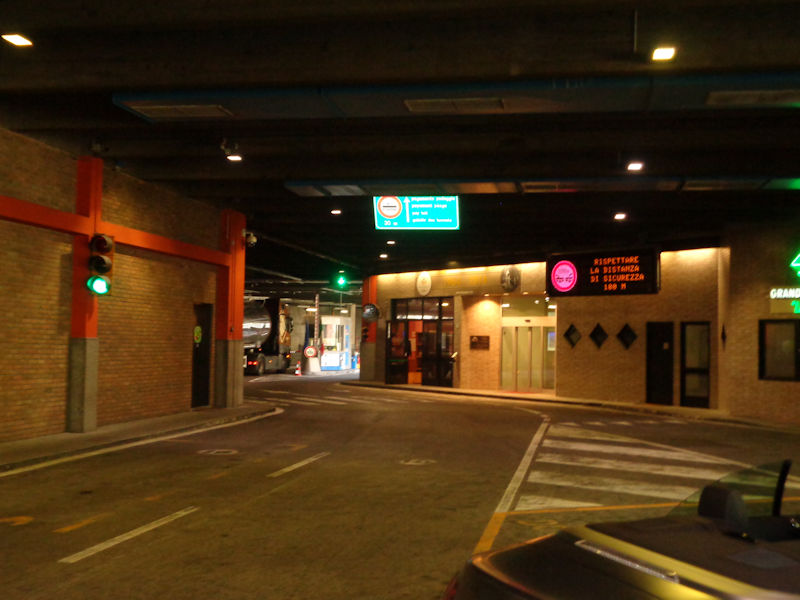
Paying our fair dues on the carload of Grignolino at the Grand St Bernard Tunnel entrance into Switzerland -- the end of a wonderful excursion into the Langhe area of the Piemonte . . . The Land (as we've learnt to our delight) of the Miraculous Tajarin!!!

 Dwight Peck's personal website
Dwight Peck's personal website






































































